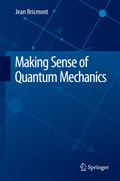
Making Sense of Quantum Mechanics
J. Bricmont: Making Sense of Quantum Mechanics, Springer, Heidelberg 2016, 331 S., geb., 51,99 €, ISBN: 9783319258898
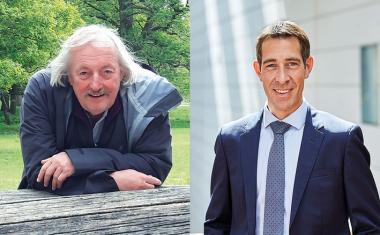 1/2025 • Seite 53 • DPG-Mitglieder
1/2025 • Seite 53 • DPG-MitgliederLaudationes auf die Preisträgerinnen und Preisträger der Deutschen Physikalischen Gesellschaft
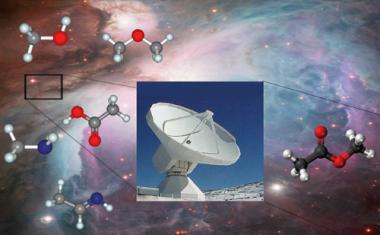 • 9/2024 • Seite 63 • DPG-Mitglieder
• 9/2024 • Seite 63 • DPG-MitgliederThe study of molecules with large amplitude motions takes us on a journey from molecular structure to astrophysics.
Spectroscopy allows us to use light to explore, detect and quantify molecules in the interstellar medium, in the atmospheres of planets and exoplanets, in comets, stars, and so on. Spectroscopy also makes it possible to determine the three-dimensional structure of complex molecules and of molecules that form the building blocks of biological molecules (biomimetics). Gas phase spectroscopy gives information about intramolecular dynamics occurring in molecules.
Internal rotors are molecules containing an atom or a group of atoms that can rotate through a torsional angle α relative to the other parts of the molecule. This motion is hindered by a potential barrier, so the internal rotation is not “free” (Fig. 1). Internal rotation or torsion is called Large Amplitude Motion (LAM) because the internally rotating group of atoms moves far away from equilibrium positions compared to the bond lengths.
V(α) is the internal rotation potential function (Fig. 1), which has a 2π/3 periodicity for a methyl rotor top (–CH3). It can be expressed in the following Fourier series in terms of the torsional angle α, the leading term V3 is called the height of the barrier [1, 2]: (...)
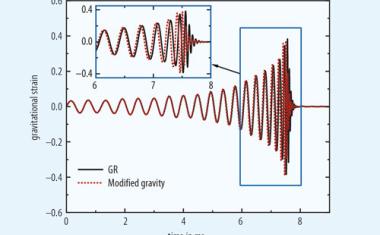 • 9/2024 • Seite 76 • DPG-Mitglieder
• 9/2024 • Seite 76 • DPG-MitgliederGravitational waves promise to shed light on fundamental physics through observations of dark compact objects.
Gravitational waves provide a unique window into the most cataclysmic events in the universe, from the Big Bang to black hole mergers. They complement traditional electromagnetic astronomy and, in addition, reveal phenomena that were previously hidden from our view.
The direct detection of gravitational waves in 2015 [1] was among the most important discoveries in fundamental physics in recent decades and a proof of one of the fundamental predictions of General Relativity (GR). The signal was observed by the two underground LIGO detectors in Hanford and in Livingston (Fig. 1); the comparison of the data in the bottom plot demonstrates that both detectors witnessed the same event. At least two detectors operating simultaneously are needed to confirm the detection because these instruments are so sensitive that various noises might contaminate the signal, such as seismic activities or even animals walking on the ground above the detector. In addition, it is very important that the observed signal matches the theoretical prediction very well. This is a confirmation that the observed gravitational wave event is a merger of two compact objects with spacetime curvature in their vicinity reaching extreme values. Even though a number of exotic scenarios cannot be excluded, the most probable one is that these were two colliding black holes. (...)
Dave MacLellan (AILU)
Antonio Castelo (EPIC)
EPIC’s technology manager Antonio Castelo met Bjorn Andersen from a Danish developer of novel polymer optical fiber sensor systems.
Taking-off as a three-person startup in 1998, Toptica’s vision at the time was to humbly add its tunable diode lasers to the field of scientific photonics and to make a living for around ten people within five years.
Based on hyperspectral cameras from the Finnish manufacturer Specim, researchers have developed a smart all-in-one spectral imaging laboratory system for standardized automated data acquisition and real-time spectral model deployment.
Antonio Castelo (EPIC)
Europe needs a battery industry. Internal combustion is a mastered technology on the old continent, but European companies need to improve their electric vehicle capabilities to reduce the gap to other markets.
Louise May (Luxinar)
In contemporary automotive production, automation is pervasive, and robots have become integral to manufacturing processes. To further improve efficiency and versatility, lasers have emerged as indispensable tools, supplanting conventional methods and offering numerous advantages in the automotive manufacturing landscape
Donald Tibbitt (Epolin)
Near infrared (NIR) light is becoming pervasive within products to improve perception, functionality, and safety. NIR is used in applications ranging from lidar and automotive ADAS to machine vision systems, night vision cameras, IR remotes, touch screens, and various medical and therapeutic uses.
Florian Friedl & Luigi Ghezzi (both: Hamamatsu Photonics)
Many features in today’s modern cars are designed to support drivers on their journeys all over the world. Working in the background and invisible to most, some of these hidden components provide us with increased comfort and safety no matter what the driving conditions are like.
Martin Grolms & Viktor Glushych (both: Fraunhofer ILT)
Thanks to SMaC, high-strength coating materials can be applied quickly and efficiently, and simultaneously finished by machining.
An enormous number of production steps are required before a car completes its first miles on the road. (Cognex)
Sylvia Weise, Manuel Walch, and Hermann Senninger (all: AMS Osram)
The automotive industry has undergone a revolution in lighting as LED technology has enabled new design opportunities, more brightness, and new imaginative effects.
Wilhelm Kaenders (Toptica Photonics)
Ivan Nikitski (EPIC)
The Swiss developer of high quality, high-speed signal acquisition products, reveals his secrets in a conversation with EPIC’s technology manager for quantum and PICs.
Jérémy Picot-Clémente (EPIC)
The managing director and the technical coordinator of the European pilot-line association Phabulous, which is providing highly advanced and robust manufacturing technology for optical free-form microstructures, talk to EPIC photonics technologies program manager Jérémy Picot-Clémente.
The presentation of the Quantum Effects Award 2023 will be one of the highlights during Quantum Effects, Trade Fair and Conference for Quantum Technologies, which will be held in Stuttgart on 10 and 11 October 2023. The Award recognizes outstanding innovations that connect the classical and quantum worlds, are used in different industries, enable individual services and open up new perspectives. This also applies to components that significantly advance quantum technologies and solutions.
Maike Pfalz (Wiley)
The physicist Michael Förtsch founded the high-tech startup Qant out of the Trumpf Group in 2018 to develop novel sensors and photonic computer chips. The company uses light as the fundamental resource to realize the potential of quantum technology. Qant now has almost eighty employees at its Stuttgart location.
Anja Knigge, Christian Knothe, and Tobias Kroker (all: Schäfter+Kirchhoff)
Technical progress in both industry and science has enabled the preparation, manipulation, and probing of quantum systems with an unprecedented level of control. This provides the basis for a multitude of so-called quantum technologies like quantum cryptography, quantum sensors and quantum computers, which are currently developing from laboratory experiments into commercial applications.
Stefan Rank ∧ Frank Deppe (both: IQM Quantum Computers)
Quantum computers promise to solve certain advanced computational tasks with higher computational speed, higher accuracy, and less energy consumption. To be useful for real-world applications, traditional quantum algorithms typically require significantly more sophisticated quantum computers than are available today.
Co-designing application-specific quantum integrated circuits (ASICs) is one avenue being explored by quantum computing scientists and engineers to achieve quantum advantage in the near future. Currently, the co-design paradigm is most prominently pursued in the field of superconducting quantum systems, which operate in the microwave regime.
Nevertheless, due to the universality of the underlying light-matter coupling mechanisms, insights taken from the field of photonics could provide valuable contributions to the advancement of co-designed quantum computers.
The Quantum 2.0 shift needs excellent industrial laser systems that exceed key benchmarks such as integration, scalability, and ease of use. Toptica has taken bold steps to meet the need by introducing an innovative feature, the ‘quad laser operation’ option. This groundbreaking addition allows users to easily control up to four DFB or DL pros.
Laseroptik uses dedicated equipment to apply dielectric coatings to large optics up to 2 m in length (long axis for rectangular shapes) or 1 m in diameter with a superior spectral uniformity over the complete surface and high LIDT values.
Spectroradiometers are the key component for a wide range of light measurement tasks in many innovative applications. Radiometric, photometric and colorimetric properties are calculated from their spectral data with the aid of extensive software suites, such as SpecWin Pro. Their precision and accuracy are therefore especially important for exact readings.
Optical filters selectively control light of a particular wavelength or polarization and are essential across many industries in applications such as machine vision, microscopy, spectroscopy, or chemical analysis. Because optical filters are available in numerous sizes and specifications, understanding the nomenclature and key terms will help to differentiate between them.
Laser technology is based on the principles of quantum mechanics and works by exciting atoms or molecules to a higher energy level, and then allowing them to release that energy in the form of a highly focused beam of light. This technology has many advantages over traditional technologies, such as greater precision, faster processing speeds, and higher energy efficiency.
Jim Bovatsek (MKS Spectra-Physics)
Lithium-ion batteries are the energy storage medium of choice for myriad applications. The enormous demand worldwide is reaching new heights, motivating the development of lower cost, faster production methods. With all these efforts to economic efficiency, the quality of the manufactured batteries must remain at the highest level, a goal that can only be achieved if all the individual components meet their respective quality specifications. MKS, with its different brands in the photonics industry, has conducted intensive research to support customers in optimizing their laser-based production processes. The latest research shows the advantages of using picosecond IR lasers with burst mode.
Günther Leschhorn (Instrument Systems)
Vertical-cavity surface-emitting lasers (VCSELs) are perfectly suited to fulfill the requirements of present and future 3D-sensing applications. However, prior to operating VCSEL-based devices in public, manufacturers must ensure safe operation compliant with the IEC 60825-1 standard or corresponding national equivalents.
Matthew Everett, Jay Skidmore, and Alex Ju (all: Lumentum)
VCSEL-based lidar solutions can accelerate the adoption of ADAS – and ultimately, fully autonomous vehicles – by providing higher performance, greater efficiency, increased accuracy, and higher reliability at a lower cost, compared to existing systems. The flexibility of VCSEL technology makes these systems suitable for 3D sensing applications throughout the car, including in-cabin sensing, short-range sensing (<1 m), and long-range sensing (>200 m).
Frank van Mourik (Flash Pathology), Marloes Groot (VU Amsterdam), and Oliver Prochnow (Hübner Photonics / Valo Innovations)
The choice of femtosecond lasers for use in multiphoton microscopy is not trivial. It is a fine balance between peak power, pulse energy and laser wavelength. In this white paper we discuss important laser parameters and the impact these have on the quality of the results.
Jan Wagner & Holger Schlüter (both: Scanlab)
Developing laser processes for industrial applications is a challenging and laborious task. Conventional controllers for laser scan systems lack the ability to predict the actual path of the laser beam on the workpiece, making extensive trial-and-error testing of different parameters and delay settings necessary in order to achieve satisfactory results. Finding a balance between the accuracy achieved and throughput is typically a compromise, and varies from user to user. Thanks to the introduction of SCANmotionControl, a new software solution by Scanlab, the programming of laser processes has been revolutionized.
Lukas Rimgaila (Ekspla), Tadas Bartulevičius (Ekspla), Deividas Andriukaitis (Ekspla), Valdemar Stankevič (Akoneer), Arnas Vyšniauskas (Akoneer), and Oliver Rohm (Topag Lasertechnik)
The development of ultrafast lasers with higher functionality as a result of recent advances in the study of light-matter interaction has revolutionized the micromachining of materials with greater accuracy and a smaller heat-affected zone. The popularity of femtosecond lasers in industry has furthered enhancements to their flexibility and efficiency, including different methods of operation such as in the FemtoLux 30, enabling new techniques in material processing.
Battery boxes in electric vehicles can influence more than just vehicle dynamics. The fire risk posed by batteries makes them crash-relevant components. For this reason, high-strength aluminum alloy structures are used in production, although they are markedly susceptible to hot cracking; the quality of the weld seams is a decisive factor in their strength. Scansonic, one of the world's leading manufacturers of laser machining optics, is presenting its product portfolio at Laser World of Photonics in Munich.
Lenses are widely used as a basic optical element in daily life. They are used in cameras, eyeglasses, microscopes, and many other devices. The lenses are developed based on classical refractive optics, which leads to unavoidable imaging errors such as chromatic as well as spherical aberration and coma. To minimize these, conventional imaging systems usually use multiple lenses of different powers and materials.
PM bv, a manufacturer of precision linear bearings and linear slides in the Netherlands, has the smallest linear precision slide available in the industry, the MSR 3. It is designed for the optical, microelectronics, and laser industry where precise movements are required, often within tight installation spaces. The design offers ultrasmooth motion and high repeatability.
Oliver Fähnle, Kerstin Kern, Jan Allaart, Henrik Surberg (all: Eastern Switzerland University of Applied Sciences, Jens Bliedtner, Christian Schulze, Sebastian Henkel, Volker Heineck (all: Ernst Abbe University of Applied Sciences), Jürgen Bode, Michael Wagner (both: Satisloh)
Additive technologies allow the flexible production of gradient index (GRIN) polishing tools with specifically adaptable removal functions. These were successfully developed and investigated for synchrospeed polishing.
Faiza Houta, Michael Quinten (Dr Quinten Wissenschaftlich-technische Software)
Optical thickness determination with miniaturized spectrometers is a commonly used technique that works quite well in many applications. For sintered materials however, this technique must be extended by the determination of the optical constants of the sintered material. This can be done using a combination of scanning electron microscopy and effective medium approaches. In this article, we demonstrate this for the optical thickness determination of sintered Al2O3 layers in quartz tubes.
Prof. Constantin Häfner (Fraunhofer ILT)
Frank Münchow, Karthik Iyer (both: Instrument Systems)
Lulu Wang, Lulu Song, Xueqing Wang (Shenzhen JPT Opto-Electronics)
Jim Bovatsek (MKS Spectra-Physics)
Kolja Kolata (for SmarAct)
Oren Aharon (Duma Optronics)
Thomas Willemsen (Laseroptik), Uddhab Chaulagain, Stefan Borneis (both: ELI Beamlines), Wolfgang Ebert (Laseroptik)
Bo Gu (BOS Photonics)
Thierry Robin, Benoît d'Humières, Jacques Cochard (all: Tematys)
Charlotte Helzle (hema electronic)
Eric Mottay (Amplitude Systèmes)
Takaaki Yamanashi (Amada)
André Häusler (Fraunhofer ILT), Marc Hummel (RWTH)
Olga Resnik, Yosi Arazi, Yoni Kaganovitz, Assaf Levy-Beeri (all: Joya Team)
Jérémy Picot-Clémente (EPIC)
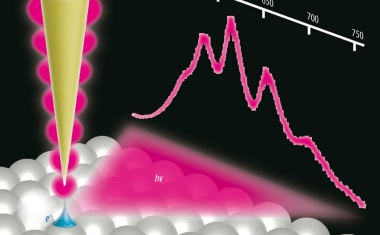 • 9/2020 • Seite 59 • DPG-Mitglieder
• 9/2020 • Seite 59 • DPG-MitgliederPhotophysical and photochemical phenomena are directly observable using low-temperature scanning tunneling microscopy combined with plasmonics.
Nanolight originates from localized surface plasmon excitation in metallic nanostructures. It possesses great potential for local optical spectroscopy down to the single-molecule level and for the enhancement of photophysical and photochemical processes such as solar energy conversion and photocatalytic reactions. Sophisticated experiments combine scanning tunneling microscopy with laser optics and allow the direct investigation of the microscopic mechanisms of nanolight-driven phenomena in plasmonic nanogaps. In addition, it is possible to perform optical spectromicroscopy at an unprecedented spatial resolution.
Confining light into a small volume enhances the interaction of light and matter. Versatile applications range from imaging and spectroscopy to optoelectronic devices and photocatalysis. With conventional optics, the spatial confinement of light is limited to a few hundred nanometers due to the diffraction limit. To realize a further confinement and to turn on “nanolight”, metallic nanostructures can generate localized electromagnetic fields at the nanoscale through collective electron oscillations, so-called surface plasmons [1]. If a localized surface plasmon resonance efficiently couples to propagating light, the electromagnetic fields are confined to a sub-wavelength scale.
The advancement of highly precise fabrication techniques of metallic nanostructures has fueled the rapid growth of plasmonics and nanophotonics in the last few decades [2]. Plasmonic nanogaps formed between metallic nanoparticles are of particular interest to fundamental physics and applications because of an extreme field enhancement (Fig. 1a). They enable single-molecule detection as well as an enhancement of photophysical and photochemical processes by orders of magnitude. (...)

J. Bricmont: Making Sense of Quantum Mechanics, Springer, Heidelberg 2016, 331 S., geb., 51,99 €, ISBN: 9783319258898

Bei Molybdändisulfid bestimmt die Schichtdicke über den Übergang in den supraleitenden Zustand.
 • 9/2015 • Seite 41
• 9/2015 • Seite 41Quantum fluctuations played a crucial role in the formation of the structure of our universe.
On March 21, 2013 something very remarkable happened. The Planck science team released a highly precise photograph of our universe when it was only few hundred thousand years old. This photograph is so detailed that it shows some major features that the universe acquired only 10–35 seconds after creation. Most strikingly, the observed nontrivial features in the portrait of such a young universe came in exact agreement with what had been predicted by the theorists more than thirty years ago, long before the experiment was carried out. Without any exaggeration one can say that by now it is experimentally proven that quantum physics, which is normally considered to be relevant in atomic and smaller scales, also played the crucial role in determining the structure of the whole universe, including the galaxies, stars and planets.
Of course scientists and philosophers have always been interested in the origin of our universe. However, cosmology only became a natural science less than a hundred years ago. It was not until 1923 that the American astronomer Edwin Hubble was able to resolve individual stars in the Andromeda Nebula and to conclude that for sure it is located outside of our own galaxy. This was the beginning of extragalactic astronomy. Today it is well established that there are about a hundred billion galaxies in our universe. Thus, the stars form galaxies with a size of about a hundred thousand light years. Moreover, the distance between neighboring galaxies is a few million light years. Observing the spectral lines of the galaxies, Hubble discovered that they are slightly redshifted. He interpreted this as a Doppler shift due to the relative motion of the other galaxies, which try to escape from us. Hubble also found that the spectral lines of galaxies further away show higher redshift. This means that they are escaping with higher velocities, proportional to the distance (v→ = H r→) and thus the universe expands. This discovery was the beginning of scientific cosmology.
With Hubble’s discovery it became clear that our universe is evolving as a whole. This did not come as a big surprise! In 1922 the Russian physicist Alexander Friedman had found that the generic solutions of the Einstein’s equations describe either an expanding or a contracting Universe. Assuming that the total mass of the universe is about a hundred billion times larger than the mass of our galaxy, Friedman was even able to conclude that the universe must be about 10 billion years old. Thus, Hubble’s discovery can be considered as a brilliant confirmation of the theoretical prediction by Friedman. The most important conclusion from Hubble’s discovery was that the universe was created about several billions years ago. This extremely important discovery remained for many years the single experimentally established fact in cosmology. Only after more than thirty years the other piece of the puzzle was discovered. ...
 • 9/2014 • Seite 37
• 9/2014 • Seite 37Life as a problem in nonequilibrium statistical mechanics
We review some problems in nonequilibrium physics from the point of view of statistical physics and differentiable dynamics. Specifically, we discuss the mathematical difficulties which inherently underlie applications to heat transport, to hydrodynamic turbulence, and to the study of life. The microscopic dynamics of transport phenomena (in particular heat transport) is necessarily non hyperbolic, which explains why it is a difficult problem. The 3D turbulent energy cascade can be analyzed formally as a heat flow, and experimental intermittency data indicate that this requires discussing a Hamiltonian system with 104 degrees of freedom. Life is a nonequilibrium statistical physics phenomenon which involves chemical reactions and not just transport. Considering life as a problem in nonequilibrium statistical mechanics at least shows how complex and difficult the study of nonequilibrium can be.
The aim of nonequilibrium statistical mechanics is to understand the properties of matter outside of equilibrium, starting from microscopic dynamics. At this time nonequilibrium statistical mechanics of transport phenomena close to equilibrium is a well-developed physical theory (due to the work of Onsager, Green, Kubo, etc. in the 1950’s, see for instance [1]). Away from this area, the theory of nonequilibrium is a program, or a variety of programs, rather than a theory. Here I shall make a choice, and describe an approach starting with classical Hamiltonian microscopic dynamics. From my point of view this approach has the interest that it uses nontrivial recent results in the theory of smooth dynamical systems, and that it sheds light on interesting physical phenomena: heat transport, hydrodynamic turbulence, and life. (...)
 • 9/2012 • Seite 41
• 9/2012 • Seite 41From disorder and quantum chaos to topological insulators
Quantum mechanical systems with some degree of complexity due to multiple scattering behave as if their Hamiltonians were random matrices. Such behavior, while originally surmised for the interacting many-body system of highly excited atomic nuclei, was later discovered in a variety of situations including single-particle systems with disorder or chaos. A fascinating theme in this context is the emergence of universal laws for the fluctuations of energy spectra and transport observables. After an introduction to the basic phenomenology, the talk highlights the role of symmetries for universality, in particular the correspondence between symmetry classes and symmetric spaces that led to a classification scheme dubbed the “Tenfold Way”. Perhaps surprisingly, the same scheme has turned out to organize also the world of topological insulators.
Let me begin by expressing that I feel greatly honored to be this year’s recipient of the Max-Planck medal, and I appreciate the opportunity to give a talk on some of the work that may have earned me this distinction. To set the stage and give you a flavor of what is to come, let me remind you of the old but still fascinating story of universal conductance fluctuations (UCF). Predicted theoretically in the middle of the 1980s by Altshuler [1] and by Lee and Stone [2], UCF was investigated in a large number of experiments. It was found that in a great variety of different mesoscopic systems − such as a small gold ring for example, or an even smaller silicon MOSFET − the electrical conductance displays characteristic fluctuations of the order of one when expressed in units of the conductance quantum e2/h (Fig. 1). What is most remarkable is that the size of the fluctuations in a broad range of parameters does not depend on the system dimension, the disorder strength, etc., but only on a few fundamental symmetries.
It was realized early on that there exists a close connection with the fluctuations that had been observed decades earlier in the scattering cross section of slow neutrons on atomic nuclei. This far reaching connection is at the very root of what I have to say. It led, among other things, to the development of a broad framework in which to model and calculate mesoscopic effects such as UCF. ...
 • 9/2011 • Seite 29
• 9/2011 • Seite 29Theoretical progresses in off-equilibrium behavior of glassy systems
Many systems approach equilibrium very slowly. Their equilibration time becomes macroscopic and is sometimes so large that it cannot be measured. Significant progress have recently been made in understanding the collective phenomena that are at the basis of this behavior, especially in structural glasses and spin glasses.
The typical microscopic time scale in condensed matter physics is the picosecond. However sometimes the time to approach equilibrium is much larger (e. g. seconds, years ....). When the gap between the microscopic and the macroscopic time becomes very large, the most common scenarios are the following:
- There is a localized microscopic process with large activation energy that is responsible for the very large equilibration time.
- All the localized microscopic processes are fast: there is no single very large energy barrier and the very slow behavior is a collective effect.
The most well understood collective effects happen at a second order phase transition point where there are large-scale excitations that involve a large number of atoms. At the phase transition point the spatial correlation length diverges and at the same time scale becomes very large (critical slowing down): in this situation the characteristic times are much larger than the microscopic time, but usually they still remain microscopic (e. g. they diverge at the critical temperature Tc as |T–Tc|–1.4 with a prefactor that is of order of the microscopic time scale). ...

Müssen wir Newtons Gravitationstheorie modifizieren, weil sie viele Beobachtungsbefunde der Astrophysik nicht erklären kann?
Mesoscopic physics is a sub-discipline of condensed-matter physics that focuses on the properties of solids in a size range intermediate between bulk matter (macroscopic) and individual atoms (microscopic). In particular, it is characteristic of a domain where a large number of particles can interact in a quantum-mechanically correlated fashion. In this article, it is shown that the collective spins of large and complex magnetic molecules can be tuned between their classical and quantum regimes thus enabling studies at the border of the two.
Statistical mechanics relates the behavior of macro-scopic objects to the dynamics of their constituent microscopic entities. Primary examples include the entropy increasing evolution of nonequilibrium systems and phase transitions in equilibrium systems. Many aspects of these phenomena can be captured in greatly simplified models of the microscopic world. They emerge as collective properties of large aggregates, i.e. macroscopic systems, which are independent of many details of the microscopic dynamics
We discuss the partonic structure of the proton, and outline how the parton densities may be determined. We use them to predict the event rates of various processes which may be observed at the forthcoming Large Hadron Collider at CERN. We briefly discuss how to observe a „light" Higgs boson (of mass less than 140 GeV), and emphasize the advantages of an exclusive Higgs signal.
The concept of quarks and leptons as the basis for the understanding of the fundamental structure of matter and forces was established in the late sixties and early seventies, culminating in the discovery of the J/ψ particle in the so-called ''November revolution'' of 1974. This particle was subsequently interpreted as the bound state of a new heavy quark, the charm quark, and its antiparticle. The subsequent discovery of the heavy lepton, the τ, and the even heavier bottom and top quarks completed the picture of the fermion content of the Standard Model of particle physics.
During the last years there has been a rapidly growing interest in the field of cold molecules. This has obviously been inspired by the spectacular successes in the closely related field of cold atoms, which have recently been recognized by the award of the 2001 Nobel Prize in Physics to Cornell, Ketterle, and Wieman for ''the achievement of Bose-Einstein condensation in dilute gases of alkali atoms, and for early fundamental studies of the properties of the condensates.'' But molecules have much more to offer than simply extending the experiments already performed with atoms to more complex species.